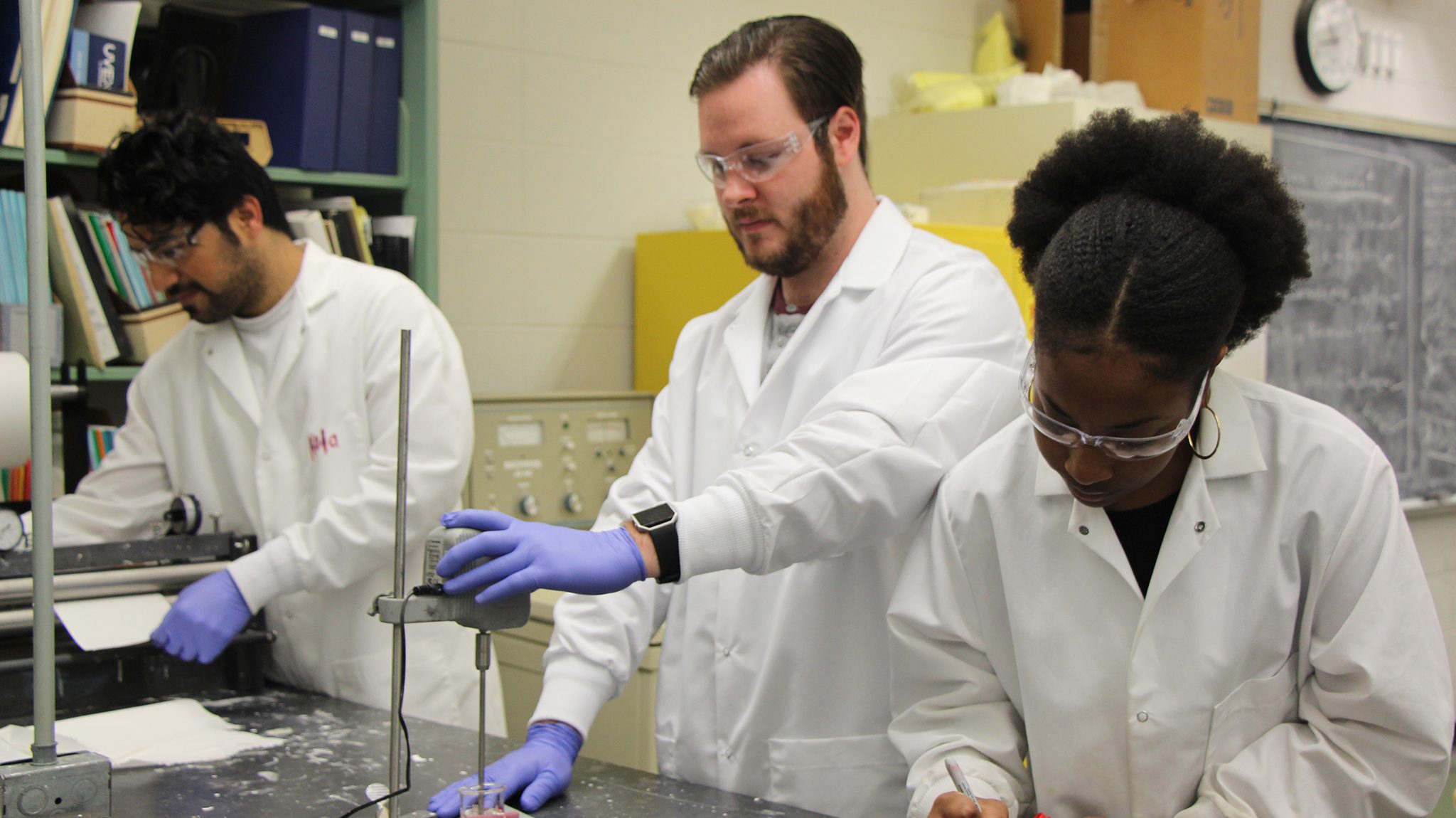
Chemical engineering majors Anas Al-Abri (left), Brandon Knight and Shaylin Williams conduct lab experiments in Brenda Prager’s Coatings, Surfaces and Interfaces Research Group. Submitted photo
Three years ago, Brenda Prager received a parcel of medications from her Australian pharmacist. As it was winter in Australia, the parcel was badly damaged because of wet weather, and the box containing the medications fell apart upon opening.
“It struck me at the time that a cheap but strong, hydrophobic-coated surface over this paper-based package would have gone a long way in protecting my medications,” said Prager, an assistant professor of chemical engineering at the University of Mississippi.
About the same time, a friend sent her some much-wanted “Aussie chocolate.” The Mississippi heat, however, melted the tasty treats.
“Thermal barrier coatings, in this case, would have enabled my beloved Cadbury’s to have arrived safely during transportation,” she said.
Fed up with ineffective package wrappings, Prager created the Coatings, Surfaces and Interfaces Group (CSIG), a research team dealing primarily with the development of intelligent and functional coatings onto paper substrates for packaging applications and investigating their surface behavior, functionality, interactions with the paper substrate and mechanical strength properties.
“Three types of coatings are currently being investigated: hydrophobic, or water repellent, coating; thermal barrier coatings; and antibacterial coatings,” Prager said. “Using the same fundamental science of surfaces and interfaces, I’ve also expanded my research into a fourth project area, investigating oil-spreading behavior over soils, a phenomenon occurring during an oil spill. Understanding this fundamental behavior may lead to modified incident responses following an oil spill.”
The CSIG group includes three graduate researchers (one of whom is a former undergraduate research student of Prager’s): Kola Adenekan of Nigeria, who is working toward his Ph.D. in engineering science; Anas Khalaf Al-Abri of Oman, who has begun his master’s degree in engineering science; and Mustafees Khan of India, who recently completed his master’s in engineering science.
The graduate students help supervise 10 undergraduate students, all chemical engineering majors. They are Claire Cozadd of O’Fallon, Illinois; Osas Imafidon of Lagos, Nigeria; Jared Foster of Horn Lake; Shaylin Williams of Natchez (a McNair Scholar); Aransa Gonzalez of Caracas, Venezuela; Brandon Knight of Collinsville; Ebrima Komma of the Gambia in West Africa; Adam Luckett of Jackson; Jordan Ryan of Gulfport; and Mitch Sypniewski of Vero Beach, Florida.
“Many of my students begin in my research group as volunteers to get a taste of research,” Prager said. “While not all stay in the group, those who do are typically drawn into the excitement that research brings and genuinely enjoy the challenges and higher-order thinking required to successfully conduct the research.”
Komma entered the research group after having taken Prager’s mass and energy balance course last summer.
“I wanted to put into practice the theories that I learned, so I talked to Dr. Prager about research, and she told me about the CSIG research group,” Komma said. “The work they do there interested me, so I gladly joined when she offered me a position.”
The most rewarding part for Komma has been the hands-on experience.
“Making a hydrophobic coating on a filter paper sounds fancy, and being able to be a part of that will help me grow my knowledge in chemical engineering,” he said. “I haven’t particularly gone deep into what (I) am supposed to do, but I do have the gist of it.”
Ryan said being able to work with such an incredible team is what he finds most rewarding.
“Though I’ve been on this research team for a short time, Dr. Prager’s involvement and leadership is such a critical part of our work,” he said. “Also, knowing that our research might solve real-world problems is very gratifying.”
Other students are introduced to research by teaming up with Prager to complete their honors project or by taking credit hours in ChE 330, a class specifically designed for students to conduct research in chemical engineering.
While most of these projects were initially funded by Prager’s startup money, the hard work by her team has enabled two successful research grants to be received: a NASA seed grant (Award NNX 15AH78H) investigating thermal barrier coatings (October 2017 to September 2018) and a USDA Agriculture and Food Research Initiative seed grant (Award No. 2018-67022-27972) investigating thermal barrier and hydrophobic coatings for food packaging applications (June 2018 to May 2020).
“These grants have allowed some of the undergraduate researchers to undertake paid research work and employ a new master’s student on the thermal barrier project,” Prager said. “Brandon was also able to attend the 2018 American Coatings Conference in Indianapolis, finding it an enriching experience.”
Prager is searching for another master’s student to lead the soil remediation work using departmental funds awarded to her for this project. She is also preparing a small grant for the antibacterial coatings project.
“I actively recruit students into my research group, encouraging women and other minorities to consider these opportunities,” Prager said. “There is a dual benefit: The students learn the nuts and bolts of how to do research and cultivate higher-order thinking skills in areas related to their class work. Their hard work then enables research grants to be written and publication of results in journal articles.”
Prager said necessity usually dictates the focus of her research projects.
“I’ve spent most of my working life in industry and academia dealing with all sorts of coatings – photographic coatings, paperboard coatings and biomedical coatings on point-of-care sensors, investigating in-depth their respective functionalities, surface and interfacial properties,” she said.
“It was my damaged medications and melted chocolates which inspired me to create this particular research group. The end must justify the means.”